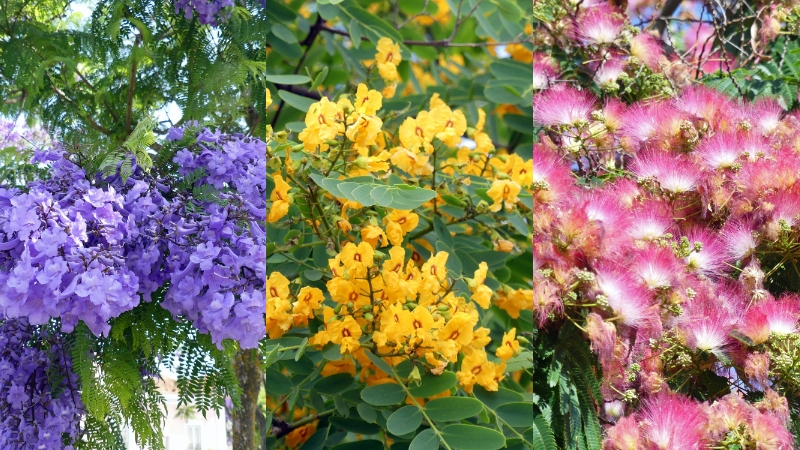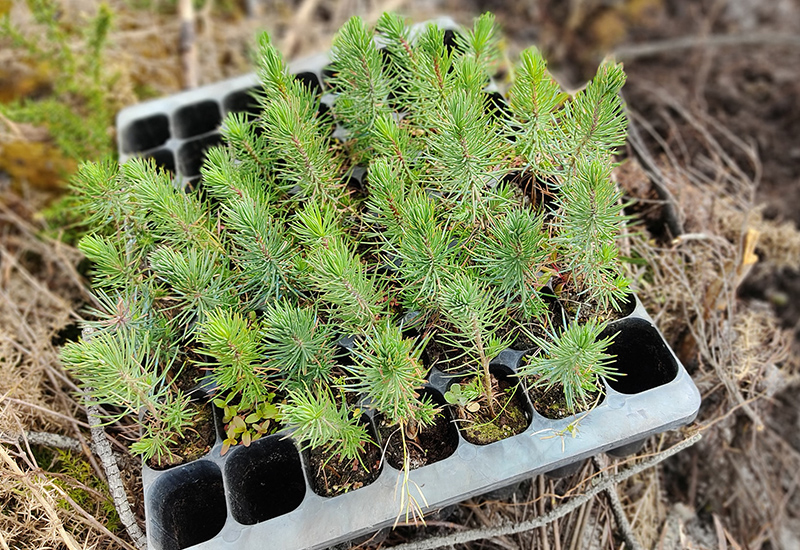By Tamsin Varley
Inspired by her trip to Madeira, where a lot of different trees were in full bloom, Tamsin Varley investigates the best options for flowering trees in the Algarve. These will provide spectacular viewing for your garden.
JACARANDÁ

One of my favourite flowering trees in the Algarve is Jacaranda mimisifolia, which produces glorious violet-coloured flowers in May and June. It is a sub-tropical tree that is native to South America. When young, it won’t tolerate frost, but established trees will take temperatures down to -7C. Even if a young tree is damaged by frost, it might die back, but will regenerate from the rootstock and grow into a large multi-stemmed shrub. After flowering, the tree will be covered in numerous large woody seed pods, which are very decorative. After flowering, the light green fern-like leaves appear, which are very attractive and give good shade. A mature tree can reach between eight to twelve metres in height with an equal to greater spread, so do plan carefully when you plant one. Initially, the tree will grow quite quickly and can easily add two to three metres in height in its early years if given plenty of water.
PRIDE OF BOLIVIA

Another tree which was grown in spectacular avenues in Madeira is Tipuana tipu also known as Pride of Bolivia, which is also native to South America. It is a very fast-growing spreading tree often grown for shade but with the added bonus of bright yellow flowers in early summer. This is an easy tree to grow as it is tolerant of a wide range of growing conditions, including saline soils, is drought tolerant once established and can take frost down to -4C. These trees can grow up to 30 metres tall with a spread of 20 metres, so allow plenty of room for one. One note of caution is that the tree is renowned for its aggressive root system, so do not plant too close to buildings or pools.
THE SILK TREE

I recently noticed a very attractive flowering tree near the vaccination centre in Silves, which I later identified as Albizia julibrissin or the Silk tree, native to the south-west and east Asia. It is a small deciduous tree that grows about ten metres tall and six metres broad, making it an ideal shade tree. Its leaves are large and frond-like and close up at night. The beautiful flowers form pink, fluffy terminal clusters in the summer. It is reasonably fast-growing and can survive drought, but does best with infrequent very deep watering in the summer.
THE CHINABERRY

Another useful flowering tree is Melia azedarach, also known as Chinaberry, Indian Bean Tree or Persian Lilac, which originates from India and China. It is a fast-growing deciduous tree up to fifteen metres high with a spread of eight metres. It forms a multi-branched open tree with attractive grey bark. Its leaves are fern-like with oval, toothed leaflets. In spring, it has clusters of small star-shaped purple flowers that are followed by long-lasting yellow berries, which are poisonous to both humans and cats. This tree is very easy to grow, is wind resistant and is also drought tolerant, requiring no summer water once established so ideal for difficult sites.
Tamsin Varley is a member of Clube Dos Bons Jardins, a small, friendly multi-national garden club that meets at different locations around the Algarve on the 2nd Tuesday every month except over the summer with an optional lunch afterwards.
algarvecbj@gmail.com














